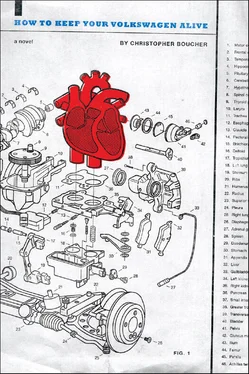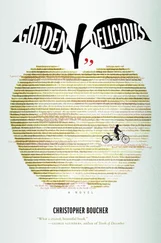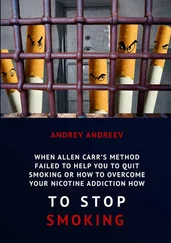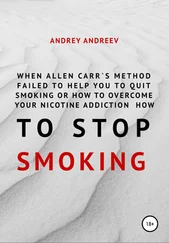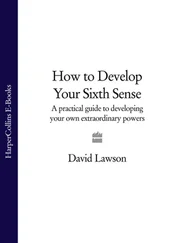In the event of an unshift, open up the engine compartment and remove the control unit. Then, take out the momentpump. Underneath it you’ll see a middle transmission, encased completely in glass. Some Beetle owners describe the transmission as taco-like — I’ve heard others say it looks like a bird in a glass coffin. Like I say, every car is different. Plus, the transmission is still a sort of mystery-vision for me — I know that it connects to the engineheart (where stories are bred), for example, but I can’t say how. All I can tell you is that the transmission connects the story to the reader, and thus, that it’s an integral part of the car.
If the transmission is unshifting, you may have a storylinkage problem, in which case something is keeping the story from moving forward. To investigate this, undo the sufferbolts around the edges of the glass casing and take a look inside. You’ll see a series of interlocking narratives. Is there any schmutz between them, any wrinkle or disconnect that you can see?
Once, my car’s transmission was malfunctioning because of a piece of storyfuzz, and as soon as I removed it the car ran like an awning. Usually, though, I’m not so lucky — it’s more likely that you’ll open the casing and find a narrative deteethed or twisted, in which case you’ll need to order a replacement for it.
If you want to drive the car in the meantime, you’re going to have to shift it yourself — to push the story forward manually.
Let’s say, for example, that the story is:
Your son is a 1971 Volkswagen Beetle who has disobeyed you and left the house on his own. When you open the door to his room you find the afterstory:condensers, scraps of tin and steel, diagrams, translators, pages of verbs in various languages. These words are the first things you see, depaged and collected in a shoebox by the door. You pick up the box and look through the words: “mlape,” “svesket,” “marchon,” “balinquoo,” “quandary.” There’s not one term you recognize.
You step into the room and see strange engine components, some books about aerodynamics, a notebook full of sketches, charts and diagrams on the wall. You scan one of these charts, which appears to denote topographical musical notation. Another drawing, which is taped above the VW’s worktable, appears to be a hand-drawn map. You study the jagged, intersecting lines. That crooked trail there appears to be a river, but which river?
Then you study the volksenscratch notes — here he’s written the number two, and there the number five, and—
No.
Suddenly you see: This is a drawing of Route 91, from Northampton to Greenfield.
The Volkswagen has gone after the Heart Attack Tree.
That explains the maps, the engineering books, the projects. He wasn’t working on a birthday present , but the very opposite — an unpresent, the gift that keeps on taking away.
Understand that your Volkswagen has no concept of the highwaysong — what the tune is, how to hear it or steer it. He won’t even know if he’s in the verse or the chorus. And he’s sick — he’s very, very sick.
He won’t make it to Deerfield .
And you, suddenly sans car, have no way to catch up with him. The narrative has unshifted.
Were that the case, you might shift the story manually, like this:
First Gear: The Volkswagen is your responsibility. This is your fault, and no one else’s.
Second Gear: He will die in the sound if you don’t find him.
Third Gear: What are you waiting for? There is not a second of time-of-money to waste.
Fourth Gear: Go! Go now.
GRINDS AND GROWLS (TRANSAXLE)
I grabbed the heavy power-in-pieces and ran out the door, down the hill to Prospect Street, over to King Street and towards the entrance to 91. In twenty minutes I was sprinting up the on-ramp, my mind a needle. Before I reached the top of the ramp, even, I could see the flush of vehicles — Veggies, bioleggers, riffs and phrases, traveling vests and fences, etcetera. The choruslanes were jammed; vehicles switched aggressively from one staff to the next and some even jumped over the driver in front of them. Up ahead, I saw a biolegger elbow a fence on its way past, and the fence spin onto the median.
It began to rain. I put my hands over my ears — the drops of sound were deafening .
I stuck out my thumb and began running along the breakdown lane. I was crying and waving for help, but no one would stop — VeggieCars and bio’s shrilled past me, yelling insults out the window. “Get off the road, you crazy vosk ,” shouted a woman in a carcoat, and then a shower on bio’s viced “Don’t you know the storysong is only a metaphor ?”
“For what?” I shouted back. She couldn’t hear me, so the question ran along beside me. And it was just one of several: Did I really think I could catch the VW? That I would find my father this way? And which direction was I going, anyway — towards the past, or fast-forward towards a future?
Yes. Yes to every question. I was running towards my family, towards life. I believed — I still believe — that his heart was still beating. That my heart was still beating. That your heart is still beating.
• • •
I’d been sprinting along the highwaysong for about ten minutes when I suddenly saw a blue 1971 Volkswagen Beetle driving in the other direction. I stopped running and tried to flag it down. Thank god! “VW!” I shouted.
But the car was driving ethereally fast, and when it sped past me I saw that it was brand new —the notes bounced off of its shiny blue paint. This car wasn’t my son. I stopped waving to it, and watched it disappear around the bend of the previous verse.
As I was standing there a jazzy, syncopated riff approached and pulled over. Inside was a trio of instruments — a piano in the front seat, a bass and drums in the back.
I was drenched by the musical rain, and I’d been weeping and mumbling so I’m sure my face was red and swollen. When the piano rolled down the film, he read my face and said, “Need a ride?”
I got into the riff. “Noisy night, huh?” the piano said, steering us back into traffic.
“Did you just come from Springfield?” I said.
“Hartford,” said the bass fiddle.
“You didn’t see a Volkswagen driving in the other direction, did you?”
“A what?” the drum set said. His voice was smoky and cracked.
“A Volkswagen,” I said. “It’s a kind of car. They’re sort of round? This one’s blue.”
“Jesus,” the drums said. “I’ve never even heard that word before.”
“I think I might have seen one of those as a kid, in a museum somewhere,” said the piano.
“Is that why you’re out here?” said the bass. “Did you lose your car?”
“My son, yes,” I said.
The bass asked, “Is he traveling south?”
“I don’t think so — I think he’s going north, towards Greenfield,” I said. “But I’m not sure — he left home this morning and didn’t tell me where he was going.”
“He ran away?” the piano said, furrowing his wooden brow.
“It’s a long story — a whole novel, actually, and this is the wrong version. He left to follow — to track — a farm.”
“A farm ?” the piano said.
I nodded. “And I forbade him from traveling on ninety-one. Who can navigate with all this noise ?”
“Tell me about it,” the drums said. “We weren’t even supposed to have come this far — numb notes missed our exit a few miles back.”
“Numb-notes,” the bass said, smiling dumbly.
Then the drums leaned forward — I could feel him studying me. “What’s that?” he said.
Читать дальше
